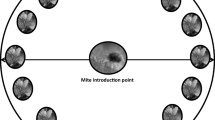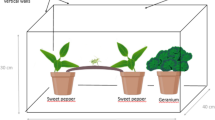Abstract
Host plant resistance (HPR) is the most promising alternative to aphidicides used to control bird cherry-oat aphid, Rhopalosiphum padi L. infestation in wheat. A variety of experiments including locomotory, olfactometry (antixenosis), nymphiposition, relative growth and development bioassay (antibiosis), and tolerance studies were conducted to underpin the category of HPR for R. padi resistance in diploid Aegilops tauschii Coss. accessions pau 14232 and 14576 along with susceptible hexaploid Triticum aestivum L. variety HD 2967. R. padi nymphs showed a lower intrinsic rate of increase (0.192), weight gain (46.41–49.50 µg), mean relative growth rate (0.026–0.029), nymphal survival (43–48%), adult longevity (10.7–11.17 days), total development period (25.45–25.65 days) with a prolonged nymphal duration (13.4 days) on Ae. tauschii accessions as compared to susceptible check (HD 2967). Bird cherry-oat aphid also showed reduced locomotory and nymphiposition behaviour on Ae. tauschii. In the olfactometry assay, R. padi indicated less preference for diploid Ae. tauschii accessions. However, no significant difference observed in tolerance parameters viz. percentage proportional fresh plant loss index and percentage proportional dry plant loss index between Ae. tauschii accessions and HD 2967. Results showed that the R. padi resistance in Ae. tauschii pau accessions are governed by a combination of antixenosis and antibiosis.





Similar content being viewed by others
References
Abrol DP, Shankar U (2014) Pesticides, food safety and integrated pest management. In: Pimental D, Peshin R (eds) integrated pest management. Springer Science, UK, pp 167–185
Akhtar N, Moin N, Jilani G, Mohsin A, Yasmin S, Tashfeen A, Goraya M, Begum I (2009) Evaluation of resistance in wheat against Rhopalosiphum padi (l) (Homoptera: Aphididae) under laboratory conditions. Pakistan J Agric Res 22:67–72
Araya JE, Foster JE, Cambron SE (1987) A study of the biology of Rhopalosiphum padi (Homoptera: Aphididae) in winter wheat in northwestern Indiana. Great Lakes Entomol 20:47–50
Blackman RL, Spence MJ, Normark BB (2000) High diversity of structurally heterozygous karyotypes and rDNA arrays in parthenogenetic aphids of the genus Trama (Aphididae: Lachninae). Heredity 84:254–260
Brisson N, Gate P, Gouache D, Charme G, Oury FX, Huard F (2010) Why are wheat yields stagnating in Europe? A comprehensive data analysis for France. Field Crops Res 119:201–212
Cao HH, Pan MZ, Liu HR, Wang SH, Liu TX (2015) Antibiosis and tolerance but not antixenosis to the grain aphid, Sitobion avenae (Hemiptera: Aphididae), are essential mechanisms of resistance in a wheat cultivar. Bull Entomol Res 105:448–455
Castro AM, Martin A, Martin LM (2006) Location of genes controlling resistance to greenbug (Schizaphis graminum Rond.) in Hordeum chilense. Plant Breed 115:335–338
Chander S, Aggarwal PK, Kalra N, Swaruparani DN (2003) Changes in pest profiles in rice-wheat cropping system in Indo-gangetic plains. Ann Plant Prot Sci 11:258–263
Coon BF (1959) Grass hosts of cereal aphids. J Econ Entomol 2:994–995
Das BC, Sarker PK, Rahman MM (2008) Aphidicidal activity of some indigenous plant extracts against bean aphid Aphis craccivora Koch (Homoptera: Aphididae). J Pest Sci 81:153–159
Development Core Team R (2013) R: a language and environment for statistical computing. R foundation for statistical computing, Vienna, Austria. http://www.R-project.org
Dixon OA, Bramel-Cox PJ, Reese JC, Harvey TL (1990) Mechanisms of resistance and their interactions in twelve sources of resistance to biotype E greenbug (Homoptera: Aphididae) in sorghum. J Econ Entomol 83(1):234–240
Elek H (2013) Aphid resistance in wheat varieties. University of Pannonia, Georgikon Faculty, Keszthely, Hungary
Emden VHF, Bashford MA (1969) A comparison of the reproduction of Brevicorynebrassicae and Myzuspersicae in relation to plant age and leaf amino acids. Entomol Exp Appl 14:349–360
Foster JE, Stamenkovic SS, Arayaa JE (1988) Life cycle of Rhopalosiphum padi (L) (Homoptera: Aphididae) on wheat in the laboratory. J Entomol Sci 23:216–222
Garzo E, Soria C, Gomez-Guillamon ML, Fereres A (2002) Feeding behavior of Aphis gossypii on resistant accessions of different melon genotypes (Cucumis melo). Phytoparasitica 30(2):129–140
Gibson RW, Plumb RT (1977) Breeding plants for resistance to aphid infestation. In: Harris KF, Maramorosch K (eds) Aphids and virus vectors. Academic Press, New York, NY, pp 473–500
Girvin J, Whitworth RJ, Rojas LMA, Smith CM (2017) Resistance of select winter wheat (Triticum aestivum) cultivars to Rhopalosiphum padi (Hemiptera: Aphididae). J Econ Entomol 110:1886–1889
Havlickova H (1997) Differences in level of tolerance to cereal aphids in five winter wheat cultivars. Rost Vyroba 43:593–596
Hesler LS (2005) Resistance to Rhopalosiphum padi (Homoptera: Aphididae) in three triticale accessions. J Econ Ent 98:603–610
Hesler LS, Riedell WE, Kieckhefer RW, Haley SD, Collins RD (1999) Resistance to Rhopalosiphum padi (Homoptera: Aphididae) in wheat germplasm accessions. J Econ Ent 92:1234–1238
Hesler LS, Riedell WE, Kieckhefer RW, Haley SD (2002) Responses of Rhopalosiphum padi (Homoptera:Aphididae) on cereal aphid-resistant wheat accessions. J Agric Urban Entomol 19:133–140
Khan Z, Khan SA, Khan H, Khan N, Junaid K, Khan I (2017) Seven local commercial wheat cultivars tested for resistance against Rhopalosiphum padi L in Pakistan. Pak J Zool 49:793–799
Kieckhefer RW, Gellner JL (1992) Yield losses in winter-wheat caused by low-density cereal aphid population. Agron J 84:180–183
Leather SR, Dixon AFG (1984) Aphid growth and reproductive rates. Entomologia Experimentalis Et Applicate 35(2):137–140
Loxdale HD (2008) The nature and reality of the aphid clone: genetic variation adaptation and evolution. Agric for 10:81–90
Luo K, Yao XJ, Luo C, Hu XS, Hu ZQ, Zhang GS, Zhao HY (2020) Previous aphid infestation induces different expression profiles of genes associated with hormone dependent responses in near-isogenic winter wheat lines. J Econ Entomol 113:461–470
Nevo E, Korol AB, Beiles A, Fahima T (2002) Evolution of Wild Emmer and Wheat Improvement. Springer, Berlin, Heidelberg, pp 11–17
Niemeyer HM (1990) The role of secondary plant compounds in aphid-host interactions. In: Campbell RK, Eikenbary RD (eds) Aphid-Plant Genotype Interactions. Elsevier, Amsterdam, pp 87–205
Ou XQ, Ru ZG, Hu TZ, Shi MW (2005) Tolerance of the main wheat cultivars in Henan Province to wheat aphids. Acta Tritical Crops 25:125–127
Petterson J, Pickett JA, Pye BJ, Quiroz A, Smart LE, Wadhams LJ, Woodcock CM (1994) Winter host component reduces colonization by bird cherry-oat aphid, Rhopalosiphum padi (L.) (Homoptera: Aphididae), and other aphids in cereal fields. J Chem Ecol 20:2565–2574
Radford PJ (1967) Growth analysis formulae – their use and abuse. Crop Sci 7:171–175
Razmjou J, Golizadeh A (2013) The effect of wheat cultivars on biological attributes of bird cherry-oat aphid, Rhopalosiphum padi (Homoptera: Aphididae). J Crop Prot 2:331–341
Razmjou J, Mohamadi P, Golizadeh A, Hasanpour M, Naseri B (2012) Resistance of Wheat Lines to Rhopalosiphum padi (Hemiptera: Aphididae) under laboratory conditions. J Econ Entomol 105:592–597
Riedell WE, Kieckhefer RW (1995) Feeding damage effects of three aphid species on wheat root growth. J Plant Nut 18(9):1881–1891
Sheoran OP, Tonk DS, Kaushik LS, Hasija RC, Pannu RS (1998) Statistical Software Package for Agricultural Research Workers. In: Hooda DS, Hasija RC (eds) Recent Advances in information theory Statistics and Computer Applications. Department of Mathematics Statistics, CCS HAU, Hisar, pp 139–143
Singh B, Deol GS (2003) Quantitative grain yield losses caused by aphid complex in wheat. Crop Res 26:501–504
Singh B, Kaur S, Chhuneja P (2018) Evaluation of plant resistance in progenitors of wheat against foliage feeding aphids. Agric Res J 55(1):117–121
Singh B, Simon A, Halsey K, Kurup S, Clark S, Aradottir GI (2020) Characterisation of bird cherry-oat aphid (Rhopalosiphum padi L.) behaviour and aphid host preference in relation to partially resistant and susceptible wheat landraces. Ann Appl Biol 177(2):184–194
Smith CM (2005) Plant resistance to Arthropods: molecular and conventional approaches. Springer, Netherlands, pp 19–130
Smith CM, Schotzko D, Zemetra RS, Souza EJ, Schroederteeter S (1991) Identification of Russian wheat aphid (Homoptera: Aphididae) resistance in wheat. J Econ Entomol 84:328–332
Taheri S, Razmjou J, Rastegari N (2010) Fecundity and development rate of the bird cherry-oat aphid, Rhopalosiphum padi (L.) (Homptera: Aphididae) on six wheat cultivars. Plant Protect Sci 46:72–78
Voss TS, Kieckhefer RW, Fuller BE, Mcleod MJ, Beck DA (1997) Yield losses in maturing spring wheat caused by cereal aphids (Homoptera: aphididae) under laboratory conditions. J Econ Ent 90:1346–1350
Wickham H (2009) ggplot2: elegant graphics for data analysis. Springer, New York, pp 65–90
Wigglesworth VB (1939) The principles of insect physiology. Chapman and Hall Ltd., London, pp 826–827
Wyatt IJ, White PF (1977) Simple estimation of intrinsic increase rates for aphids and tetranychid mites. J Anim Ecol 14:757–766
Zeb Q, Rondon SI, Naeem M, Khan SA, Goyer A, Vleet SV, Corp MK (2016) Categorization of putative factors against Rhopalosiphum padi (L.) (Heteroptera: Aphididae). J Econ Entomol 109:439–444
Zuo Y, Wang K, Zhang M, Peng X, Pinero JC, Chen M (2016) Regional susceptibilities of Rhopalosiphum padi (Hemiptera: Aphididae) to ten insecticides. Fla Entomol 99:269–275
Funding
The financial support provided by the Department of Biotechnology, Ministry of Science and Technology, Government of India in the form of project grant BT/PR32905/AGIII/103/1162/2019 is gratefully acknowledged.
Author information
Authors and Affiliations
Contributions
Both authors contributed to the study's conception and design. Material preparation, data collection, and analysis were performed by Miss Jyoti Sharma and Dr Beant Singh. The first draft of the manuscript was written by Jyoti Sharma and both authors commented on previous versions of the manuscript. Both authors read and approved the final manuscript.
Corresponding author
Ethics declarations
Conflicts of interest
The authors declare there is no conflict of interest.
Additional information
Publisher's Note
Springer Nature remains neutral with regard to jurisdictional claims in published maps and institutional affiliations.
Rights and permissions
About this article
Cite this article
Sharma, J., Singh, B. Unravelling the category of host plant resistance in Aegilops tauschii Coss. against the bird cherry-oat aphid, Rhopalosiphum padi L.. Euphytica 218, 108 (2022). https://doi.org/10.1007/s10681-022-03064-2
Received:
Accepted:
Published:
DOI: https://doi.org/10.1007/s10681-022-03064-2




